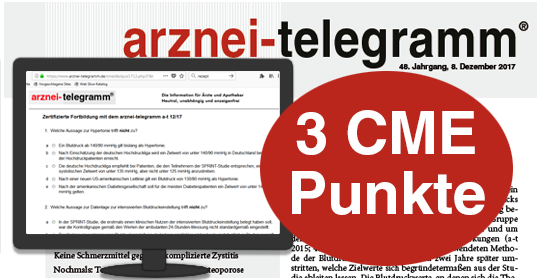Translation of a-t 2022; 53: 6-7
IN BRIEF
SGLT-2 inhibitor ertugliflozin (STEGLATRO) - "me-too" with a negative risk-benefit ratio
Ertugliflozin (STEGLATRO), the fourth SGLT-2 inhibitor to be authorised in the European Union for the treatment of type 2 diabetes, was available in Germany only as a fixed combination with the DPP-4 inhibitor sitagliptin (STEGLUJAN) until recently. Only last December, so more than three years after the authorisation, did the provider (MSD) also market the single substance preparation. MSD promotes STEGLATRO as having an "attractive price" (1). Ertugliflozin does indeed have an annual cost of EUR 475 for 5 mg or 15 mg daily, making it 19% and 32% respectively less expensive than the SGLT-2 inhibitors dapagliflozin (FORXIGA, annual cost EUR 590 for 5 mg or 10 mg daily) and empagliflozin (JARDIANCE, annual cost EUR 702 for 10 mg or 25 mg daily). However, this is the only advantage of ertugliflozin, and it is in fact a doubtful one. Unlike dapagliflozin and empagliflozin the fourth SGLT-2 inhibitor has nothing to offer other than effects on surrogate parameters such as HbA1c. In the cardiovascular safety study VERTIS CV with 8,246 people aged at least 40 with type 2 diabetes and manifest atherosclerotic disease ertugliflozin worked no better than a placebo over the course of an average of 3.5 years. A total of 11.9% of the participants receiving the study drug and the same percentage of those receiving the placebo suffered the primary endpoint - a combination of heart attacks, strokes and cardiovascular deaths (Hazard Ratio [HR] 0.97; 95.6% confidence interval [CI] 0.85-1.11). There was no significant advantage (HR 0.88; 95.8% CI 0.75-1.03) in the secondary combination endpoint of cardiovascular death or hospitalisation for heart failure established subsequently on the basis of the results of the EMPA-REG-OUTCOME study with empagliflozin (a-t 2015; 46: 95-7), nor was there any advantage in terms of cardiovascular (HR 0.92; 95.8% CI 0.77-1.11) or overall mortality (HR 0.93; 95% CI 0.80-1.08) or in a renal combination endpoint (HR 0.81; 95.8% CI 0.63-1.04). Only hospital admissions for heart failure were reduced to a similar degree as in those treated with the other SGLT-2 inhibitors (HR 0.70; 95% CI 0.54-0.90) (2). However, this further secondary endpoint is not included in the hierarchical testing (2), so the result is not robust evidence of a benefit. The range of adverse reactions is similar to that of other SGLT-2 inhibitors, with frequent urogenital infections and an increase in diabetic ketoacidosis (2). As was the case for canagliflozin (no longer marketed: INVOKANA), the risk of amputation in patients treated with ertugliflozin also seems to increase: in authorisation studies a slightly increased rate was identified already (a-t 2018; 49: 51), and in VERTIS CV non-traumatic amputations in patients treated with 5 mg or 15 mg of ertugliflozin affected 2% and 2.1% respectively, with a figure of 1.6% for the placebo (2). In light of the available alternatives, dapagliflozin and empagliflozin, with a documented clinical benefit (a-t 2021; 52: 76-8, 92, 101-2) in which increased amputation rates have not yet been described, we feel that the risk-benefit ratio of ertugliflozin is negative and advise against use of the "me-too", -Ed.
| (R = randomized study) | |
| 1 | MSD: Advertisement for STEGLATRO, Ärzte Zeitung of 10 Dec. 2021 |
| R 2 | CANNON, C.P. et al.: N. Engl. J. Med. 2020; 383: 1425-35 |
© arznei-telegramm (Berlin/Germany), January 2022, protected by copyright laws.
Autor: Redaktion arznei-telegramm - Wer wir sind und wie wir arbeiten
Diese Publikation ist urheberrechtlich geschützt. Vervielfältigung sowie Einspeicherung und Verarbeitung in elektronischen Systemen ist nur mit Genehmigung des arznei-telegramm® gestattet.
